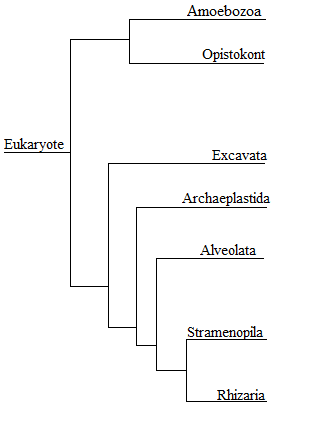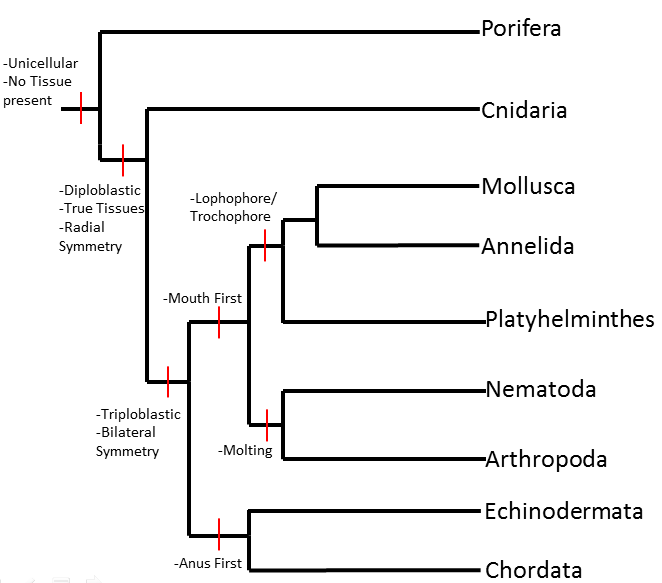Classification
Domain: Eukarya (specialized organelles)
Kingdom: Animalia (multicellular; heterotroph)
Phylum: Annelida (segmented worm)
Class: Polychaeta (contains prominent parapodium for locomotion)
Order: Phyllodocida (benthic creatures)
Family: Syllidae (worm)
Genus: Odontosyllis
Species: Odontosyllis phosphorea
Odontosyllis phosphorea is a eukaryote containing specialized organelles. More specifically, this species is a segmented worm which has prominent parapodium which allows for motion. O. phosphorea can be found in the benthic zone of marine environments containing salty water where it feeds off of marine deposits (Hesselberg and Vincent, 2006).
The scientific name Odontosyllis phosphorea can be broken down to find out what it means. The prefix “odonto” pertains to teeth while the suffix “syllis” pertains to worms. Phosphorea is a Latin word meaning the morning star. When put together, Odontosyllis phosphorea can be translated to mean a worm that has teeth and glows like a morning star. This is an accurate description as Odontosyllis phosphorea is a small segmented worm with teeth like structures on its parapodia and capable of bioluminescence during reproductive periods.
O. phosphorea is a eukaryotic species which can be found in the major clade Opistokont (Figure 1.). A eukaryotic organism contains a nucleus and other organelles in addition to being able to perform DNA transcription. Eukaryotes can be further classified into several clades including two major clades which are both unikonts. These two major clades are the Opistokonts and Amoebozoans. Amoebozoans are the closest clade related to the Opistokonts and ultimately O. phosphorea.
As previously stated, Amoebozoans and Opistokonts are both unikonts meaning that they both possess an oar like appendage at some point in their life cycle. They differ, however, by the way in which they move. Opistonkonts have a posterior flagellum which allows them to propel themselves at a certain point in their development. Amoebozoans, on the other hand, move via pseudopods. Pseudopods enable Amoebozoans to move through a pulling motion.
Figure 1. Phylogenetic tree showing the deviation of major clades within the eukaryote domain. (Modified from Gerrish, 2013)

Figure 2. Phylogenetic tree distinguishing characteristics between the phylum within the animal kingdom. (Modified from Gerrish, 2013)
Upon further examination, O. phosphorea can be seen to reside in the annelida phylum (Figure 2.) which has certain attributes including triploblastic tissues as well as bilateral symmetry. O. phosphorea is considered triploblastic for its three types of tissues which are ectoderm, endoderm, and mesoderm. For an organism to be triploblastic means it has increased cellular complexity which allow for the evolution of the coelom. O. phosphorea is also bilateral with a single plane of symmetry from the posterior to the anterior.
The closest relative to annelids are mollusks according to this phylogenetic tree. Mollusks and annelids are similar by the fact that they both have lophophore or trochophore larvae. Annelids, however, are segmented worms with chaetae which are hair-like structure along their body as opposed to mollusks which have a visceral mass or mantle. These visceral mantles in mollusks may or may not give rise to calcium carbonate shells which act as an exoskeleton. Annelids, on the other hand, have a coelom which is a fluid filled cavity, which acts as a hydroskeleton.
Kingdom: Animalia (multicellular; heterotroph)
Phylum: Annelida (segmented worm)
Class: Polychaeta (contains prominent parapodium for locomotion)
Order: Phyllodocida (benthic creatures)
Family: Syllidae (worm)
Genus: Odontosyllis
Species: Odontosyllis phosphorea
Odontosyllis phosphorea is a eukaryote containing specialized organelles. More specifically, this species is a segmented worm which has prominent parapodium which allows for motion. O. phosphorea can be found in the benthic zone of marine environments containing salty water where it feeds off of marine deposits (Hesselberg and Vincent, 2006).
The scientific name Odontosyllis phosphorea can be broken down to find out what it means. The prefix “odonto” pertains to teeth while the suffix “syllis” pertains to worms. Phosphorea is a Latin word meaning the morning star. When put together, Odontosyllis phosphorea can be translated to mean a worm that has teeth and glows like a morning star. This is an accurate description as Odontosyllis phosphorea is a small segmented worm with teeth like structures on its parapodia and capable of bioluminescence during reproductive periods.

O. phosphorea is a eukaryotic species which can be found in the major clade Opistokont (Figure 1.). A eukaryotic organism contains a nucleus and other organelles in addition to being able to perform DNA transcription. Eukaryotes can be further classified into several clades including two major clades which are both unikonts. These two major clades are the Opistokonts and Amoebozoans. Amoebozoans are the closest clade related to the Opistokonts and ultimately O. phosphorea.
As previously stated, Amoebozoans and Opistokonts are both unikonts meaning that they both possess an oar like appendage at some point in their life cycle. They differ, however, by the way in which they move. Opistonkonts have a posterior flagellum which allows them to propel themselves at a certain point in their development. Amoebozoans, on the other hand, move via pseudopods. Pseudopods enable Amoebozoans to move through a pulling motion.
Figure 1. Phylogenetic tree showing the deviation of major clades within the eukaryote domain. (Modified from Gerrish, 2013)

Figure 2. Phylogenetic tree distinguishing characteristics between the phylum within the animal kingdom. (Modified from Gerrish, 2013)
Upon further examination, O. phosphorea can be seen to reside in the annelida phylum (Figure 2.) which has certain attributes including triploblastic tissues as well as bilateral symmetry. O. phosphorea is considered triploblastic for its three types of tissues which are ectoderm, endoderm, and mesoderm. For an organism to be triploblastic means it has increased cellular complexity which allow for the evolution of the coelom. O. phosphorea is also bilateral with a single plane of symmetry from the posterior to the anterior.
The closest relative to annelids are mollusks according to this phylogenetic tree. Mollusks and annelids are similar by the fact that they both have lophophore or trochophore larvae. Annelids, however, are segmented worms with chaetae which are hair-like structure along their body as opposed to mollusks which have a visceral mass or mantle. These visceral mantles in mollusks may or may not give rise to calcium carbonate shells which act as an exoskeleton. Annelids, on the other hand, have a coelom which is a fluid filled cavity, which acts as a hydroskeleton.
Next page >Habitat